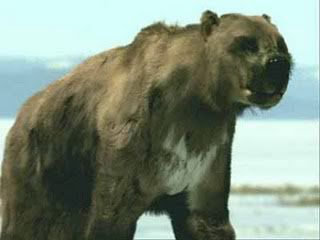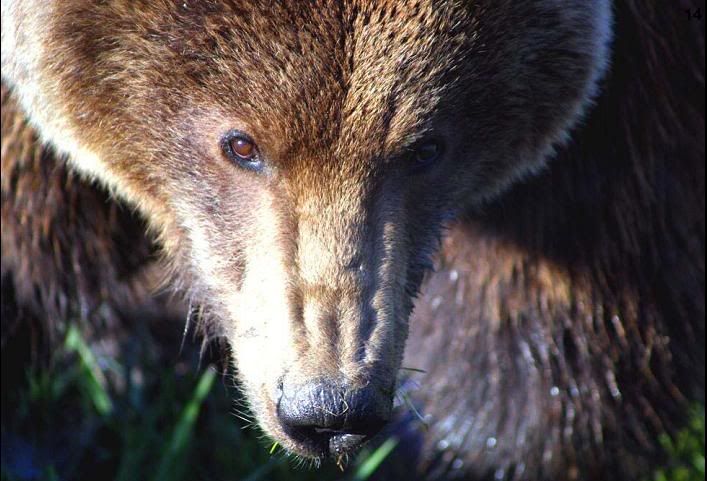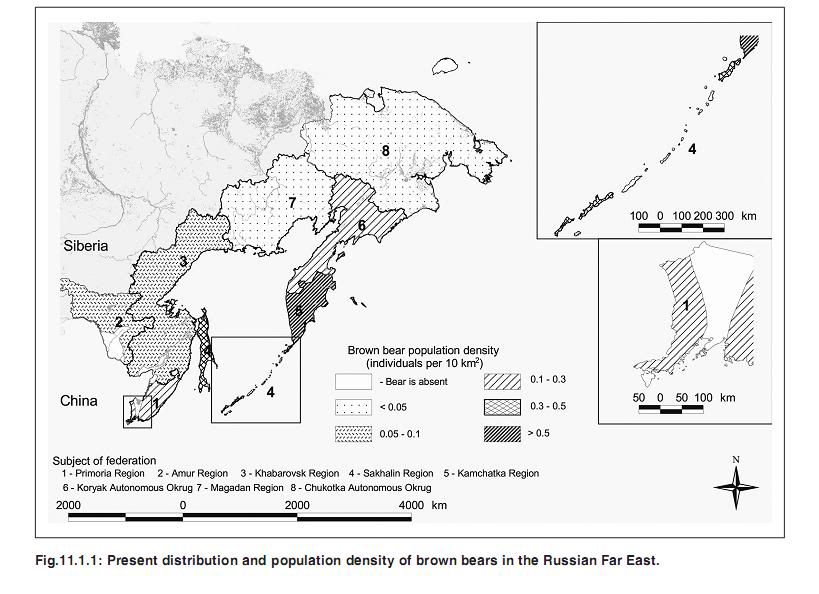Post by grrraaahhh on May 17, 2010 9:01:17 GMT -9
Taxonomy Overview:
Introduction
The brown bear (Ursus arctos L., 1758) is widely distributed through the northern Eurasia, including is- lands of the southern part of Okhotsk Sea: Shantarskie Islands, Sakhalin, Hokkaido, and southern Kuril Islands (Kunashir, Iturup). In the Late Pleistocene, this species also inhabited Honshu (Kamei 1981). Temminck (1842: 29) was the first who gave the scientific name for the brown bear from Japan: U. ferox. Lydekker (1897) and his followers (Pocock, 1932: 804, Ellermann & Morrison-Scott, 1951: 238) mistakenly treated this name to be preoccupied by U. ferox Rafinesque (1817: 437) and U. ferox Lewis & Clark in Desmarest (1820: 164). However, both latter names, which were used for the brown bear from North America, are nomina nudi; therefore, there are no nomenclature grounds to refuse Temminck s name.
Middendorff (1851: 80) described the brown bear from the Greater Shantar Island as U. arctos var. beringiana, with its distribution range comprising the eastern coast of Siberia and Japan. Ognev (1931: 94) has designated the skull of the adult male (ZIN 1226) as a lectotype for this taxon, erroneously pointing out the Smaller Shantar Island to be a type locality (see Abramov & Baryshnikov, 1990: 8). Pucheran (1855: 392), without any diagnose, named the brown bear from Kamchatka as U. piscator on the basis of the data by I. Geoffroy Saint-Hillaire, published in his report on the trip by the frigate La Vénus (holotype: mounted skin 2001-357 in Muséum National d'Histoire Naturelle, Paris).
A new species, U. lasiotus (holotype NHM 93.9.10.1), has been established by Gray (1867: 301) for the living bear brought from the inner part of Northern China and kept during a long period of time at the London Zoo (see Pocock, 1932: 799). This name has been repeatedly used for insular brown bears from southern part of the Okhotsk Sea.
Lydekker (1897: 422, fig. 3, 4) described the subspecies U. arctos yesoensis on the basis of three brown bear skulls from Hokkaido. He gave a drawing of the skull of a young adult male (NHM 86.11.18.2), which we designate as the lectotype. Another skull, belonging to adult male (NHM 96.4.27.1), is correspondingly the paralectotype. In spite of the name U. a. yesoensis is widely used
in recent publications, it seems to be a junior synonym of U. a. ferox, as well as U. melanarctos (Heude, 1898: 17) proposed for the brown bear from Hakodae in Hokkaido.
The recent authors diverged in opinions on the taxonomic position of the brown bear from islands of the southern part of the Okhotsk Sea. Ognev (1931: 104), accepting several species for the brown bear in Eurasia, suggested similarity of the Sakhalin specimens with
bears from Hokkaido, and assigned Sakhalin bears to a new unnamed subspecies of U. yesoensis. Pocock (1932) referred the brown bears from Hokkaido and southern Kuril Islands to the mainland subspecies, U. a. lasiotus, and used the name U. a. beringianus for brown bears from the western and northern coast of the Okhotsk Sea and Kamchatka. This point of view has been accepted by Ellermann & Morrison-Scott (1951) and Novikov (1956).
Stroganov (1962) regarded all the brown bears living in the Okhotsk Sea region as the subspecies U. a. beringianus. Heptner (Heptner et al., 1967) recognized two subspecies for this region: U. a. piscator (Kamchatka and Okhotsk Sea coast as far as Stanovoi Range and Shantarskie Islands southwards) and U. a. lasiotus (main-land areas to the south of Stanovoi Range, Sakhalin, southern Kuril Islands and Hokkaido), erroneously ascribing the name beringianus to bears from the north-western part of North America. Corbet (1978) assigned all the brown bears of Northern Eurasia, including Hokkaido, to the nominotypical subspecies, U. a. arctos. Later, it was revealed that the bears from the western and northern coast of the Okhotsk Sea differ from U. a. beringianus (=lasiotus), with their attribution to the subspecies U. a. jeniseensis Ognev, 1924 described from the southern part of Eastern Siberia (Cherniavsky, 1986; Cherniavsky & Kretchmar, 2001). At the same time, U. a. jeniseensis is a junior synonym of U. a. collaris Geoffroy Saint-Hillaire et F. Cuvier, 1824. Baryshnikov (Aristov & Baryshnikov, 2001) included brown bears of the northeastern Asia to the subspecies U. a. arctos, considering U. a. piscator (Kamchatka, northern Kuril Islands) and U. a. beringianus (Amur River basin, Shantarskie Islands, Sakhalin, Hokkaido, and southern Kuril Islands) to be the separate subspecies. Thus, there is no conventional view on the taxonomic status of the brown bears inhabiting Okhotsk Sea region.
Cherniavsky (1984), studying the geographical variability of U. arctos, revealed the tendency in the size decrease for bears from south (Amur River basin) and east (Kamchatka) toward northern-west (Yakutia). Besides, populations from Kamchatka and Amur River basin diverge in the width of skull zygomatic arch. The study of the U. arctos from Hokkaido has also revealed the geographical heterogeneity of the local brown bears. The clinal increase of the cranium from south to northeast has been demonstrated (Yoneda & Abe, 1976). Three morphometrically differend populations were also established (Ohdachi et al., 1992). Later, the study of mitochondrial DNA (mtDNA) revealed the presence of three bear genetic lineages (clusters A, B and C) separately located in various parts of the island and different timing of migration of each cluster to Hokkaido from the mainland (Matsuhashi et al., 1999). However, associations between morphometrical and genetic groups remain unclear.
The focus of the present study is a comparative craniometrical analysis of 3 genetic groups of brown bears in Hokkaido and reconsideration of the sub specific status for U. arctos from islands in the south parts of Okhotsk Sea.
Taxonomic differentiation of Ursus arctos (Carnivora, Ursidae) from south Okhotsk Sea islands on the basis of morphometrical analysis of skull and teeth.
zmmu.msu.ru/rjt/articles/ther3_2%2077_88%20Baryshn%20et%20al.pdf
Morphology. Yakutian bears are generally smaller than bears from other regions of Russia: the body weight of mature males in Yakutia reaches 140–150 kg (Tavrovskii et al., 1971), compared to 200–264 kg in Central Siberia (Zavatskii, 1991, 1993), 100–300 kg (Vaisfel’d, 1993) in Arkhangelsk oblast, 300–320 kg (Loskutov et al., 1993) in Bashkortostan, 250–300 kg on the Chukchi Peninsula, 300 kg in Khabarovsk krai, 400 kg in Primorye, and 600 kg in Kamchatka (Yudin, 1993). Zavatskii (1978a) attributed this fact to a relatively poor food supply and severe environmental conditions of Yakutia. Craniometric parameters of Yakutian bears also differ considerably from those of bears from northeastern Siberia, Kamchatka, the Amur basin, and Sakhalin (table).
Specific Ecological Features of the Brown Bear. (Ursus arctos L. 1758) in Yakutia
Introduction
The brown bear (Ursus arctos L., 1758) is widely distributed through the northern Eurasia, including is- lands of the southern part of Okhotsk Sea: Shantarskie Islands, Sakhalin, Hokkaido, and southern Kuril Islands (Kunashir, Iturup). In the Late Pleistocene, this species also inhabited Honshu (Kamei 1981). Temminck (1842: 29) was the first who gave the scientific name for the brown bear from Japan: U. ferox. Lydekker (1897) and his followers (Pocock, 1932: 804, Ellermann & Morrison-Scott, 1951: 238) mistakenly treated this name to be preoccupied by U. ferox Rafinesque (1817: 437) and U. ferox Lewis & Clark in Desmarest (1820: 164). However, both latter names, which were used for the brown bear from North America, are nomina nudi; therefore, there are no nomenclature grounds to refuse Temminck s name.
Middendorff (1851: 80) described the brown bear from the Greater Shantar Island as U. arctos var. beringiana, with its distribution range comprising the eastern coast of Siberia and Japan. Ognev (1931: 94) has designated the skull of the adult male (ZIN 1226) as a lectotype for this taxon, erroneously pointing out the Smaller Shantar Island to be a type locality (see Abramov & Baryshnikov, 1990: 8). Pucheran (1855: 392), without any diagnose, named the brown bear from Kamchatka as U. piscator on the basis of the data by I. Geoffroy Saint-Hillaire, published in his report on the trip by the frigate La Vénus (holotype: mounted skin 2001-357 in Muséum National d'Histoire Naturelle, Paris).
A new species, U. lasiotus (holotype NHM 93.9.10.1), has been established by Gray (1867: 301) for the living bear brought from the inner part of Northern China and kept during a long period of time at the London Zoo (see Pocock, 1932: 799). This name has been repeatedly used for insular brown bears from southern part of the Okhotsk Sea.
Lydekker (1897: 422, fig. 3, 4) described the subspecies U. arctos yesoensis on the basis of three brown bear skulls from Hokkaido. He gave a drawing of the skull of a young adult male (NHM 86.11.18.2), which we designate as the lectotype. Another skull, belonging to adult male (NHM 96.4.27.1), is correspondingly the paralectotype. In spite of the name U. a. yesoensis is widely used
in recent publications, it seems to be a junior synonym of U. a. ferox, as well as U. melanarctos (Heude, 1898: 17) proposed for the brown bear from Hakodae in Hokkaido.
The recent authors diverged in opinions on the taxonomic position of the brown bear from islands of the southern part of the Okhotsk Sea. Ognev (1931: 104), accepting several species for the brown bear in Eurasia, suggested similarity of the Sakhalin specimens with
bears from Hokkaido, and assigned Sakhalin bears to a new unnamed subspecies of U. yesoensis. Pocock (1932) referred the brown bears from Hokkaido and southern Kuril Islands to the mainland subspecies, U. a. lasiotus, and used the name U. a. beringianus for brown bears from the western and northern coast of the Okhotsk Sea and Kamchatka. This point of view has been accepted by Ellermann & Morrison-Scott (1951) and Novikov (1956).
Stroganov (1962) regarded all the brown bears living in the Okhotsk Sea region as the subspecies U. a. beringianus. Heptner (Heptner et al., 1967) recognized two subspecies for this region: U. a. piscator (Kamchatka and Okhotsk Sea coast as far as Stanovoi Range and Shantarskie Islands southwards) and U. a. lasiotus (main-land areas to the south of Stanovoi Range, Sakhalin, southern Kuril Islands and Hokkaido), erroneously ascribing the name beringianus to bears from the north-western part of North America. Corbet (1978) assigned all the brown bears of Northern Eurasia, including Hokkaido, to the nominotypical subspecies, U. a. arctos. Later, it was revealed that the bears from the western and northern coast of the Okhotsk Sea differ from U. a. beringianus (=lasiotus), with their attribution to the subspecies U. a. jeniseensis Ognev, 1924 described from the southern part of Eastern Siberia (Cherniavsky, 1986; Cherniavsky & Kretchmar, 2001). At the same time, U. a. jeniseensis is a junior synonym of U. a. collaris Geoffroy Saint-Hillaire et F. Cuvier, 1824. Baryshnikov (Aristov & Baryshnikov, 2001) included brown bears of the northeastern Asia to the subspecies U. a. arctos, considering U. a. piscator (Kamchatka, northern Kuril Islands) and U. a. beringianus (Amur River basin, Shantarskie Islands, Sakhalin, Hokkaido, and southern Kuril Islands) to be the separate subspecies. Thus, there is no conventional view on the taxonomic status of the brown bears inhabiting Okhotsk Sea region.
Cherniavsky (1984), studying the geographical variability of U. arctos, revealed the tendency in the size decrease for bears from south (Amur River basin) and east (Kamchatka) toward northern-west (Yakutia). Besides, populations from Kamchatka and Amur River basin diverge in the width of skull zygomatic arch. The study of the U. arctos from Hokkaido has also revealed the geographical heterogeneity of the local brown bears. The clinal increase of the cranium from south to northeast has been demonstrated (Yoneda & Abe, 1976). Three morphometrically differend populations were also established (Ohdachi et al., 1992). Later, the study of mitochondrial DNA (mtDNA) revealed the presence of three bear genetic lineages (clusters A, B and C) separately located in various parts of the island and different timing of migration of each cluster to Hokkaido from the mainland (Matsuhashi et al., 1999). However, associations between morphometrical and genetic groups remain unclear.
The focus of the present study is a comparative craniometrical analysis of 3 genetic groups of brown bears in Hokkaido and reconsideration of the sub specific status for U. arctos from islands in the south parts of Okhotsk Sea.
Taxonomic differentiation of Ursus arctos (Carnivora, Ursidae) from south Okhotsk Sea islands on the basis of morphometrical analysis of skull and teeth.
zmmu.msu.ru/rjt/articles/ther3_2%2077_88%20Baryshn%20et%20al.pdf
Morphology. Yakutian bears are generally smaller than bears from other regions of Russia: the body weight of mature males in Yakutia reaches 140–150 kg (Tavrovskii et al., 1971), compared to 200–264 kg in Central Siberia (Zavatskii, 1991, 1993), 100–300 kg (Vaisfel’d, 1993) in Arkhangelsk oblast, 300–320 kg (Loskutov et al., 1993) in Bashkortostan, 250–300 kg on the Chukchi Peninsula, 300 kg in Khabarovsk krai, 400 kg in Primorye, and 600 kg in Kamchatka (Yudin, 1993). Zavatskii (1978a) attributed this fact to a relatively poor food supply and severe environmental conditions of Yakutia. Craniometric parameters of Yakutian bears also differ considerably from those of bears from northeastern Siberia, Kamchatka, the Amur basin, and Sakhalin (table).
Specific Ecological Features of the Brown Bear. (Ursus arctos L. 1758) in Yakutia












